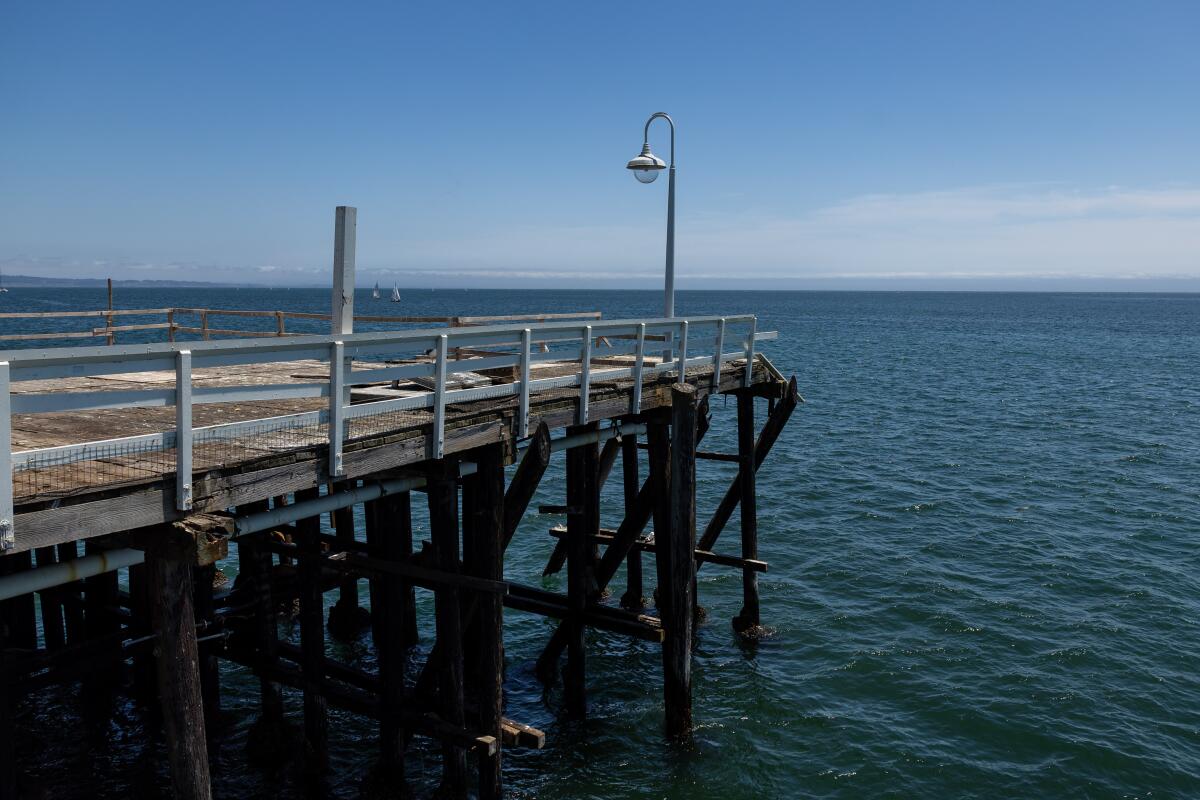-
How to spot fake login alert scams and protect your online accounts - 13 mins ago
-
Patch Adams wins 2025 Woody Stephens Stakes - 22 mins ago
-
Israel Will Block Greta Thunberg’s Boat From Reaching Gaza: IDF Chief - 28 mins ago
-
It’s a living: Earning patronage on Patreon - 31 mins ago
-
Packers Attempted to Make Intriguing Wide Receiver Trade: Report - about 1 hour ago
-
Terry Bradshaw on relationship with Art Rooney, picks Belmont Stakes winner & more - about 1 hour ago
-
Take this week’s American Culture Quiz and test your knowledge of film, sports and more - about 1 hour ago
-
Melissa Gilbert ditched glamour to land her iconic ‘Little House’ role - about 1 hour ago
-
California tsunami: What the death and damage toll could be in a disaster - about 1 hour ago
-
Israel vows to stop aid boat carrying Greta Thunberg from reaching Gaza - 2 hours ago
Will the Santa Cruz Wharf be rebuilt after it broke apart?
SANTA CRUZ, Calif. — The Santa Cruz Wharf, jutting half a mile into the Monterey Bay, offers a cheerful stroll past souvenir shops, fishing boat rentals advertised as “Husband Daycare,” and children giggling at hordes of fat sea lions barking below.
But at the end of the city-owned wharf, hanging on a flimsy metal fence, are small warning signs. “KEEP OUT,” reads one. “DANGER,” says another.
The signs have been there for about six months — ever since a 180-foot section of the wooden pier collapsed into the ocean after being battered by towering waves during an atmospheric river storm that wreaked havoc along the Central Coast.
City officials hope the signs, fencing, orange safety barriers and exposed wooden decking at the end of the wharf will be gone by early next year. Construction is expected to begin this fall on a $1-million partial repair of the structure, which draws more than 2 million visitors a year.
A portion of the Santa Cruz Wharf, including a public restroom building, collapsed into the Pacific Ocean in December 2024.
(San Francisco Chronicle / Hearst Newspapers via Getty Images)
“It’s shaken us up to see the damage to the end of the wharf,” said Tony Elliot, the city’s director of parks and recreation. “The wharf is 111 years old, and we want to make sure it’s here for another 100 plus years.”
On a sunny afternoon late last month, Nick James, a 26-year-old vacationer from Christchurch, New Zealand, leaned over the railing about 30 feet from the end of the pier, laughing at sea lions that he said were just as “noisy and smelly” as the ones back home. He was surprised to learn that the end of the wharf had fallen off.
“I just thought that was the end!” he said of the temporary fence a few feet away.
His friend Emily Lawson, 26, of Brisbane, Australia, gave the barriers a discerning look and said: “There’s not really many signs. I’m going to stay away from the end.”
The partial repair, at least some of which will be state-funded, essentially will cap and strengthen the broken end of the pier. But it remains unclear whether the portion that fell into the ocean will be rebuilt. That section once held a restaurant, a public restroom building, and several sea lion viewing holes — openings in the decking used to watch the pinnipeds lolling on the crossbeams below.
A full restoration would cost about $14 million, Elliot said. City officials have applied for funding through the California Governor’s Office of Emergency Services. But it is unclear how much money, if any, the state — which is facing a $12-billion budget deficit in the year ahead — will contribute.
Elliot said that if funding is approved, “it leads to a lot of questions about how we think about rebuilding … in the context of climate change and sea level rise and knowing that these storms aren’t going away, that they may become more frequent or stronger over time.”
The uncertainty in Santa Cruz comes as cities up and down the California coast grapple with whether to preserve their own beloved but aging piers, which have been hammered in recent years by the increasingly volatile surf of a warming and fast-rising sea.
At least 10 of the state’s dozens of coastal public piers were closed for part or all of 2024 due to structural damage sustained in winter storms over the last two years.
The Ventura Pier and Santa Cruz County’s Capitola Wharf were damaged by storms in early 2023 and reopened last year. Ventura’s restoration cost more than $3 million, and Capitola’s about $10 million.
The end of the Cayucos Pier in San Luis Obispo County has been closed to the public since it was damaged in a February 2024 storm that took out several pilings and left 15 feet of decking and railing hanging over the water without supports.
The county is taking construction bids for the removal of the damaged section until June 12, Shaun Cooper, assistant director of the San Luis Obispo County Parks & Recreation Dept., told The Times in an email Wednesday.
Construction is expected to cost roughly $250,000 and likely will begin around late August, Cooper said. It is expected to take about two months.
In Santa Cruz, a full rebuild hinges upon state funding because “we don’t have $14 million at our disposal to put toward rebuilding the end of the wharf,” Elliot said of the city.
In February, Gov. Gavin Newsom issued a proclamation of a state of emergency for the Dec. 23 storm, making Santa Cruz eligible for state funding of up to 75% of repair costs under the California Disaster Assistance Act.
The city submitted its initial damage assessments to the Office of Emergency Services in March. In a statement to The Times, Ed Chapuis, a Cal OES spokesman, said his office is reviewing the city’s damage claim to determine eligibility for funding.

Visitors watch sea lions lounging on the support beams of the Santa Cruz Wharf, which was damaged in winter storms in 2023 and 2024.
(Jason Armond / Los Angeles Times)
In April, the Santa Cruz City Council approved spending $100,000 to hire Moffat & Nichol, a Long Beach-based engineering firm, to develop plans for a $1-million partial repair.
Elliot said the initial project will replace lost pilings and decking to strengthen the end of the structure. Of the roughly 15,200 square feet of decking that fell into the sea, about 1,100 square feet will be rebuilt, according to city planning documents.
One sea lion viewing hole also will be reconstructed, Elliot said.
City officials, he said, hope to put the job out to bid by late summer and start construction in October or November, with a goal of reopening the end of the pier by early next year.
The Santa Cruz Wharf, built in 1914, was 2,745 feet long before the winter storm. It was supported by more than 4,400 pilings — 70-foot Douglas fir beams driven about 20 feet into the ocean floor.
A winter storm in 2023 knocked out about 60 pilings, Elliot said. Structural instability forced the closing and demolition of a decades-old restaurant at the end of the pier called The Dolphin.
The weakened pier was under construction for the 2023 damage when the December 2024 storm hit.

A planned partial repair of the Santa Cruz Wharf will essentially cap the broken end.
(Jason Armond / Los Angeles Times)
The city, Elliot said, is forced to do repairs in the fall and winter months, when storms are stronger and seas are choppier, in part because the California Coastal Commission will not allow work that disturbs the nesting season of coastal birds, including common seagulls, that make their nests in the wharf’s beams.
In December, two men — a city employee and a contracted engineer — who were inspecting the pier were standing on the end of it when it collapsed. They sustained minor injuries. The city employee, Elliot said, was rescued by his son, who works for the city’s marine safety division.
About 300 pilings were destroyed, with some barnacle-covered beams turning up in the Monterey Harbor, 25 miles south.
Two large pieces of construction equipment — a compact loader called a skid steer and a 20-ton crane used for driving piles into the seafloor — tumbled into the water. The skid steer was removed, but the crane has been sitting on the ocean floor beneath about 30 feet of water.
The city announced Friday that the crane and other wooden debris will be removed this weekend as part of a joint effort that includes the U.S. Coast Guard and Alameda-based Power Engineering Construction Company.
Elliot said the crane will be removed by an even larger crane perched atop a barge.
“The good news with both the skid steer and the crane: Neither were leaking or have leaked any sort of fuels or oils or anything like that,” Elliot said. “We want to get the crane out as soon as we can. It’s all weather dependent.”
Elliot said structural engineers have assessed the rest of the pier and determined it to be safe.
The wharf, he said, “is a huge economic driver for the community.” It holds about 20 small businesses that employ about 400 people, he said. It also is a place where people can fish without a permit — and some people use it for subsistence fishing to feed their families, he said.
On a recent Thursday afternoon, Leo DeRuntz, a retired plumber from nearby Live Oak, stood close to the damaged edge, smiling to himself as he watched sea lions and sail boats. While waiting for his car to be released from the repair shop, the 64-year-old had ridden his bicycle to the wharf.
He has so many fond memories of the pier. Of visiting as a child. Of bringing his three now-grown daughters when they were children, laughing as they peeked through the sea lion viewing holes and barked like the blubbery creatures.
DeRuntz said he was “devastated, in a sense,” to see his beloved pier ripped apart and hopes it will be fully rebuilt. But he also was awestruck by the ocean’s power during that storm.
“The strength of it — you have to respect it,” he said.
Nodding toward the exposed, damaged wooden decking, DeRuntz turned philosophical.
“Here’s an example of what’s not promised,” he said. “Everything that you think is stable in life could just crumble upon you. So you’d better get out and just enjoy life.”
Times staff writer Noah Haggerty contributed to this report.
Source link































